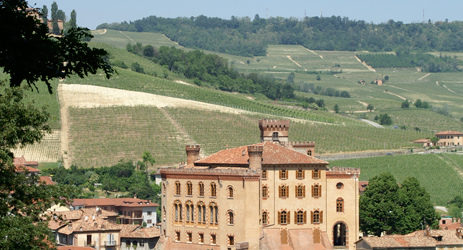Jefford on Monday
On and on they roll, the hills, one after another, combed to perfection, retreating grandly into the heat haze, frilled and filled out with copses of trees, threaded with pale tracks, and crowned with farmhouses and towers. Those hills are soothing, but mocking too: ‘understand me if you can’, they seem to say. Generally, you can’t. If you’re on your own, indeed, you’re probably lost, and fumbling with a GPS.

Burgundy, by comparison with Barolo and Barbaresco, is so simple to understand: one slope. So is Napa: one valley, with a bottom and two sides. Even rangy Bordeaux isn’t difficult, despite its generally undramatic topography, but the majestically quilted Langhe is a grand puzzle. Is that why it now has some of the best vineyard mapping in the world?
Much of the credit for this must go to cartographer Alessandro Masnaghetti, whose recently published, bilingual Barolo MGA: The Barolo Great Vineyards Encyclopedia tackles in great detail the topography of the Menzioni Geografiche Aggiuntive, introduced by the local Consorzio after many years of consultation with local growers in 2010 (for access to all of Masnaghetti’s work, consult this site). The Consorzio also publishes maps of its own of the MGAs, produced for it by Masnaghetti, and these are downloadable from here.
Menzioni Geografiche Aggiuntive or MGA is just a bureaucratically acceptable way of saying ‘vineyards’, so these maps are, if you like, the Barolo equivalent to those Burgundy maps most of us have been long familiar with, most handily accessible via the inexpensive paperback The Wines of Burgundy by Sylvain Pitiot and Jean-Charles Servant (published in Beaune by the Collection Pierre Poupon, but widely available).

With one major difference, of course: Burgundy has long had an official three-tier classification of vineyards, whereas the Barolo MGAs are ‘flat’, with no classificatory element. You could work out a classification of your own using market prices, and there is a local tradition of doing this, too. Renato Ratti’s historical classification in many ways remains the reference, but leading critic Antonio Galloni is working on his own usefully interactive version which can be viewed here. The fastidious elegance and scrupulousness which underlies Masnaghetti’s work perhaps explains his reluctance to launch into any sort of classification of his own; when you read his entries for each MGA, though, you will soon have a clear idea as how the locals esteem each site. And that’s probably enough for now.
Why? As I discovered back in May when I toured the region, the MGA system is far from universally acclaimed. The first objection is one that becomes obvious the moment you set eyes on the ‘official’ maps: some of the Barolo communes – like Monforte – decided to permit enormous tracts of hillside to claim one single name (like Bussia, Perno or Bricco San Pietro), while others, like Serralunga d’Alba, have a plethora of more tightly circumscribed vineyards, like Francia, Falletto and Lazzarito. It’s as if one region had embraced both the Burgundian and the Alsace definitions of Grand Cru simultaneously. In any case, as Roberto Voerzio points out, ‘the secret of Barolo is that everything changes every 20 metres’, so even the smaller circumscriptions will be a compromise.
Note that the vineyards aren’t all full of Nebbiolo vines, either. Their less propitious spots are full of Barbera or Dolcetto – or copses of the Tonda Gentile hazelnut trees coveted by the Alba’s Ferrero-Rocher factory. Masnaghetti’s maps show where the vineyard plantings actually are, which the official Consorzio maps don’t.

Another still more fundamental objection is that the very notion of selling an unblended Barolo is alien to the deepest traditions of the area. Five different vineyards were formerly mentioned on the label of the Bartolo Mascarello Barolo; with the 2010 vintage, that became illegal: it’s now one vineyard name or nothing. ‘The law,’ says Bartolo’s daughter Maria Teresa, ‘now imposes the French practice of making wine from single parcels on us, whereas the tradition here was to put the parcels together. We have some Cannubi vineyards – but the sandy soils there suffer in hot years. Bottling that wine on its own wouldn’t be ideal. I don’t want to stop other growers having that option, but equally I would like the law to protect me, too, since I am the one using local methods and traditions, not an imported French practice.’
One option for those who wish to continue blending to a greater extent that the 15 per cent allowed by law is to settle for ‘Barolo’ alone – yet consumers may begin to regard this, in the MGA era, as a second-rank descriptor. Another is to come up with a fantasy name, though that might be regarded as trivialising. There is some leeway for names which can prove a 25-year antecedence, by the way. Aldo Conterno’s Gran Bussia (a blend of Romirasco with Colonnello and Cicala) is allowed thanks to its long market presence. Otherwise this deformation of an MGA name would be outlawed.
Romirasco, Colonnello and Cicala are subdivisions of the enormous ‘official’ Bussia (picked out and identified by Masnaghetti in his book), raising another point: the story is not over yet.
I called the MGAs ‘vineyards’ above, but they might better be identified as ‘sub-zones’ – since the word ‘Vigna’ (vineyard) and similar forms are allowed with the MGAs, provided they have been entered in the land register. So yes, there are a lot more names out there, with more still to come, some of them in effect monopoles of one particular producer, and others vineyards in common ownership. Masnaghetti makes a valiant attempt to corral these (together with the fantasy names) at the end of his book, but the struggle must have silvered his hair and his beard a little more completely than when he began the project.
If you’re new to Barolo, you might be throwing your arms in the air at this point and thinking ‘why bother?’ Why not just scoop up the top-scoring wines of Galloni or Monica Larner or other leading critics?
If your aim is simple pleasure, that’s fine. But if you want to begin (only begin) to understand why the wines taste as they do, and how terroir is configured in this unique and rare place on earth, then the MGA maps, limpidly coloured and contoured, are a great place to start. I would love to see every wine region in a world take them as a model for their own mapping. (And what a disgrace, by the way, that Masnaghetti’s project to map the whole of Bordeaux had to be abandoned thanks to lack of local co-operation, while his Tuscan projects have languished due to a lack of local interest.)
Translated by Nina Fan Feng / 冯帆
All rights reserved by Future plc. No part of this publication may be reproduced, distributed or transmitted in any form or by any means without the prior written permission of Decanter.
Only Official Media Partners (see About us) of DecanterChina.com may republish part of the content from the site without prior permission under strict Terms & Conditions. Contact china@decanter.com to learn about how to become an Official Media Partner of DecanterChina.com.




Comments
Submit